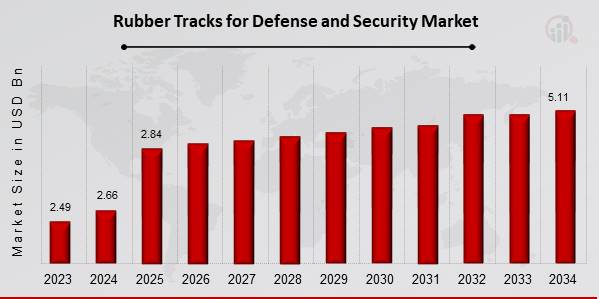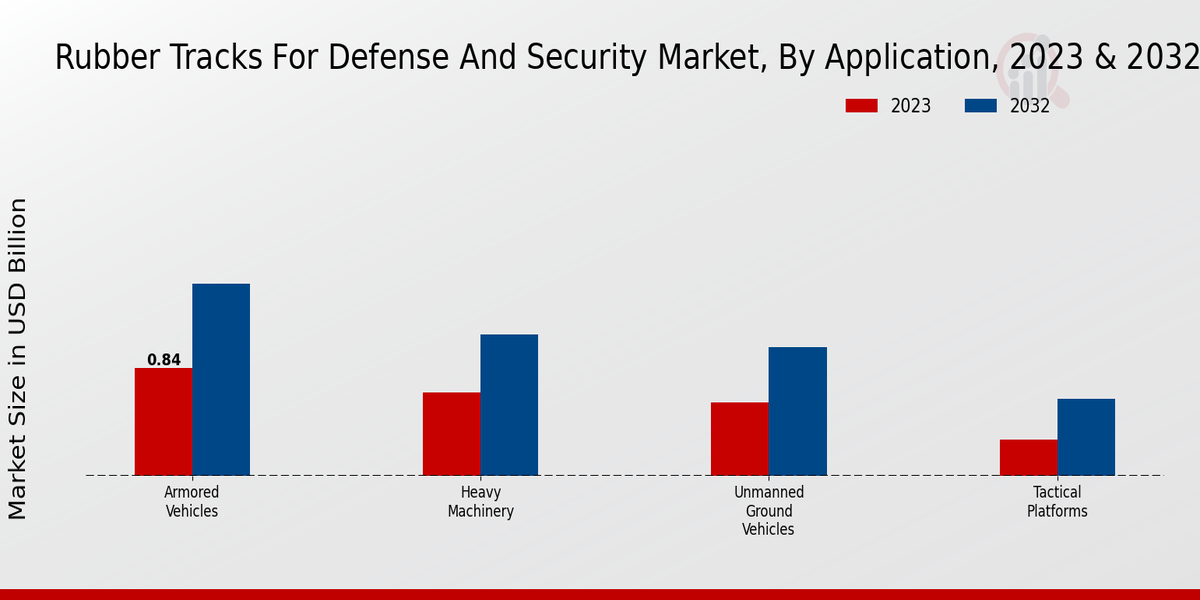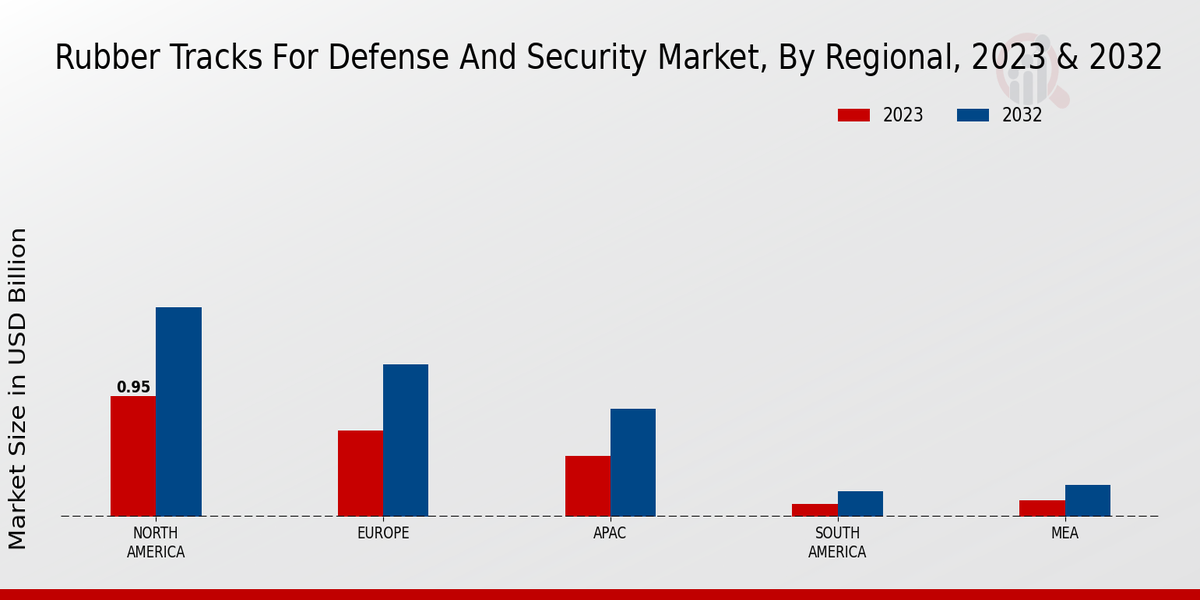Global Rubber Tracks For Defense And Security Market Overview
The Rubber Tracks for Defense and Security Market Size was estimated at 2.66 (USD Billion) in 2024. The Rubber Tracks for Defense and Security Market is expected to grow from 2.84(USD Billion) in 2025 to 5.11 (USD Billion) by 2034. The Rubber Tracks for Defense and Security Market CAGR (growth rate) is expected to be around 6.70% during the forecast period (2025 - 2034).

Source Primary Research, Secondary Research, Market Research Future Database and Analyst Review
Key Rubber Tracks for Defense and Security Market Trends Highlighted
The Rubber Tracks for Defense and Security Market is experiencing significant growth driven by advancements in military technology and a rising emphasis on mobility in diverse terrains. Defense agencies are increasingly investing in equipment that enhances operational efficiency and provides better traction, which is essential for modern military operations.
The growing need for versatile vehicles that can be deployed in various environments has led to a surge in demand for rubber tracks. Additionally, the focus on replacing traditional caterpillar tracks with rubber alternatives due to their benefits, such as reduced noise, lower ground pressure, and improved durability, is becoming a key market driver.
Opportunities in this market are abundant as manufacturers explore innovative materials and designs to improve the performance of rubber tracks. The shift towards electric and hybrid military vehicles opens new avenues for tailored solutions that cater to these emerging technologies.
Furthermore, as military forces worldwide seek to modernize their fleets, partnerships between technology firms and defense contractors can enhance product offerings, creating a competitive edge.
The trend toward sustainability and reducing the environmental footprint of military operations also presents a chance to develop eco-friendly rubber track options, aligning with efforts for greener technologies.
Recent times have seen a growing trend in research and development aimed at increasing the performance and lifespan of rubber tracks. The emphasis on lightweight materials without compromising strength is gaining traction among manufacturers.
Additionally, the advent of autonomous vehicles in the defense sector is shaping the design and functionality of rubber tracks, creating the need for more sophisticated solutions.
As military operations become more complex, the demand for adaptable rubber track systems that can support a range of missions is expected to rise, reflecting the continuous evolution of defense and security needs.
Rubber Tracks for Defense and Security Market Drivers
Increasing Demand for Enhanced Military Capabilities
The Rubber Tracks for Defense and Security Market is witnessing a significant surge in demand due to the increasing emphasis on enhancing military capabilities across various nations. This trend is driven by the necessity to maintain national security and the evolving dynamics of threats.
As military forces seek to improve their operational efficiency, the adoption of advanced mobility solutions such as rubber tracks is becoming crucial.
These tracks provide enhanced traction, stability, and durability in diverse terrains, which is essential for modern defense applications. Furthermore, the integration of rubber tracks in a variety of defense vehicles allows for improved speed and maneuverability, essential for quick response to threats.
The rising focus on countering asymmetric warfare strategies and improving logistics supportability has amplified the need for vehicles equipped with advanced rubber track systems.
Additionally, as nations are increasing their defense budgets and investing in modernization programs, the Rubber Tracks for Defense and Security Market is well-positioned for substantial growth.
Hence, the push for enhanced military capabilities presents a profound driver for market expansion in the forthcoming years.
Technological Advancements in Rubber Track Systems
Technological advancements in rubber track systems play a pivotal role in propelling the Rubber Tracks for Defense and Security Market forward. These innovations not only enhance the performance of defense vehicles but also reduce maintenance costs and improve overall operational efficiency.
Features such as noise reduction, increased load capacity, and better resistance to harsh environmental conditions are becoming standard with the latest rubber track technologies.
As the industry evolves, manufacturers are focusing on creating custom solutions that cater to the specific needs of military applications, thus providing significant opportunities for growth.
Growing Geopolitical Tensions and Defense Spending
The escalation of geopolitical tensions around the world is prompting nations to increase their defense spending, which directly benefits the Rubber Tracks for Defense and Security Market.
As countries assess potential threats, there is a concerted effort to bolster defense capabilities, leading to higher procurement of defense equipment, including vehicles equipped with advanced rubber track systems.
This trend not only highlights the growing importance of preparedness but also underscores the necessity for advanced mobility solutions that rubber tracks provide, fostering further growth in the industry.
Rubber Tracks for Defense and Security Market Segment Insights
Rubber Tracks for Defense and Security Market Application Insights
The Rubber Tracks for Defense and Security Market showcases a diverse range of applications, evidencing its critical role in modern military and defense operations.
Among the various applications, Armored Vehicles held a majority position, with a valuation of 0.84 USD Billion in 2023 and projected to reach 1.5 USD Billion by 2032. This segment's prominence is attributed to the growing need for robust, durable tracks that enhance operational efficiency and protection in high-risk environments, making them essential in conflict zones where the safety of personnel is paramount.
Heavy Machinery, another vital application, was valued at 0.65 USD Billion in 2023, forecasted to expand to 1.1 USD Billion by 2032. The significance of this segment arises from the crucial role heavy machinery plays in logistics and infrastructure development in defense, further driving demand for reliable rubber tracks that can withstand rigorous conditions.
Additionally, Unmanned Ground Vehicles, with an initial valuation of 0.57 USD Billion in 2023 and expected growth to 1.0 USD Billion by 2032, are becoming increasingly important in military strategies, reflecting a shift towards unmanned operations that enhance safety and efficiency in sensitive missions.
This growing reliance on unmanned platforms underscored the segment's strong growth potential as technologies advance. Tactical Platforms, while valued at 0.28 USD Billion in 2023 and set to rise to 0.6 USD Billion by 2032, exhibit a more niche role within the market.
This segment, while smaller, contributes significantly to specific tactical operations, underscoring the market's overall versatility in meeting various defense needs. The growth prospects across these applications highlight a broader trend toward modernization in defense technologies, driven by the quest for enhanced capabilities, increased operational safety, and efficiency.
The challenges within the market include the high costs associated with research and development, but opportunities for innovation in rubber track design present avenues for growth and expansion across the Rubber Tracks for Defense and Security Market segmentation.

Source Primary Research, Secondary Research, Market Research Future Database and Analyst Review
Rubber Tracks for Defense and Security Market Material Type Insights
The Rubber Tracks for Defense and Security Market is segmented by material type, consisting of Natural Rubber, Synthetic Rubber, and Recycled Rubber. As the market is expected to generate significant revenue growth, the materials used play a crucial role in this advancement.
Natural Rubber stands out due to its exceptional elasticity and durability, making it a favorable choice for applications requiring high performance. Synthetic Rubber, on the other hand, offers advantages like enhanced resistance to weathering and chemicals, catering to various defense and security applications, which is why it holds a substantial position in the market.
Recycled Rubber is also gaining traction, appealing to environmentally conscious initiatives within the industry, as it contributes to sustainability without compromising performance.
The growing demand for reliable and versatile rubber tracks further underscores the importance of these material types in the overall market dynamics. With evolving technologies driving innovation, the Rubber Tracks for Defense and Security Market is poised for robust expansion, ensuring that each material type contributes effectively to the industry's future.
Rubber Tracks for Defense and Security Market Vehicle Type Insights
The Rubber Tracks for Defense and Security Market, with a focus on the Vehicle Type segment, is expected to play a crucial role in the overall market trajectory.
The Vehicle Type segment encompasses various categories, including Tracked Vehicles, Wheeled Vehicles, and Hybrid Vehicles. Among these, Tracked Vehicles are integral due to their enhanced mobility over rough terrains, making them essential for military operations.
Wheeled Vehicles are also critical, offering versatility and speed, beneficial for rapid deployment in various defense scenarios.
Hybrid Vehicles, combining both tracked and wheeled attributes, are emerging as significant players, providing unique advantages in diverse operational conditions. The Rubber Tracks for Defense and Security Market data illustrates a strong demand across these vehicle types, powered by increasing defense budgets and a need for advanced military capabilities.
However, challenges such as high production costs and maintenance requirements persist. With market growth projected through 2032, focusing on innovation and technology will present opportunities to overcome these challenges and drive the Rubber Tracks for Defense and Security Market statistics further.
Rubber Tracks for Defense and Security Market End Use Insights
Within this overarching market, the segmentation highlights critical applications across Military, Paramilitary, and Civil Security. The Military segment plays a vital role, as armed forces ly require advanced mobility solutions for tactical operations, enhancing operational effectiveness on diverse terrains.
Paramilitary forces, which often operate in challenging environments, are increasingly reliant on rubber tracks for their vehicles, enabling superior maneuverability and resilience in various operational scenarios.
Similarly, the Civil Security segment is gaining prominence, with rising concerns over urban security and disaster response leading to demand for specialized vehicles equipped with rubber tracks.
The combination of these segments reflects a dynamic landscape in the Rubber Tracks for Defense and Security Market, characterized by substantial growth potential, adaptability, and a broadening scope of applications.
Rubber Tracks for Defense and Security Market Regional Insights
The Rubber Tracks for Defense and Security Market is experiencing notable growth across various regions, with North America emerging as a prominent player, valued at 0.95 USD Billion in 2023 and expected to rise to 1.65 USD Billion by 2032, indicating the majority holding in the market.
Europe followed, holding a significant market valuation of 0.68 USD Billion currently, projected to grow to 1.2 USD Billion, reflecting a strong demand driven by defense initiatives. The APAC region, with a valuation of 0.48 USD Billion in 2023 set to increase to 0.85 USD Billion, is gaining traction due to military modernization efforts among developing nations.
Meanwhile, South America and MEA showed lesser market values at 0.1 USD Billion and 0.13 USD Billion, respectively, in 2023, anticipating growth to 0.2 USD Billion and 0.25 USD Billion, highlighting these regions as emerging opportunities but currently less dominant in the market landscape.
Overall, the Rubber Tracks for Defense and Security Market segmentation showcases diverse growth potential across various regions driven by strategic defense investments and evolving security requirements.

Source Primary Research, Secondary Research, Market Research Future Database and Analyst Review
Rubber Tracks for Defense and Security Market Key Players and Competitive Insights
The Rubber Tracks for Defense and Security Market is characterized by a dynamic and competitive landscape where innovation and performance play crucial roles in shaping market strategies. The demand for high-quality rubber tracks is driven by the growing need for advanced defense and security mechanisms, especially in environments requiring enhanced mobility and durability.
Key players are focused on developing products that not only meet stringent military standards but also offer superior performance in diverse terrains. The competitive insights into this market reveal trends like technological advancements, partnerships, and strategic collaborations as companies strive to capture market share.
Companies are also increasingly investing in research and development to pioneer lightweight yet robust rubber track solutions that cater to the demands of modern defense and security operations.
Maxam Tire has emerged as a strong competitor in the Rubber Tracks for Defense and Security Market, showcasing impressive strengths that bolster its market presence. The company is recognized for producing high-quality rubber tracks that deliver exceptional performance in extreme conditions, a critical requirement in defense applications.
Maxam Tire's focus on innovation is evident through its investment in advanced material technology and design, resulting in tracks that offer enhanced traction and stability. Their commitment to quality control ensures that each product meets rigorous military specifications, further solidifying their reputation in the defense sector.
Additionally, the strategic partnerships that Maxam Tire has fostered within the military and defense industries contribute to their strong positioning, enabling them to effectively respond to evolving market demands and customer requirements.
BKT is also a significant player in the Rubber Tracks for Defense and Security Market, recognized for its robust product portfolio tailored to meet the specific needs of military and security applications. The company has established a strong brand identity grounded in quality and reliability, making its rubber tracks an attractive option for defense organizations ly.
BKT’s extensive manufacturing capabilities allow for the production of various track designs optimized for different vehicles and operational requirements. The company emphasizes continuous improvement and technological advancements, investing in research and fostering innovation in track materials and design.
Furthermore, BKT's distribution network strengthens its market presence, enabling timely delivery and support to defense organizations across various regions, thus enhancing their competitiveness in the market. Through its strategic focus, BKT is well-positioned to capitalize on the growing demand in the defense sector and effectively compete with other market players.
Key Companies in the Rubber Tracks for Defense and Security Market Include
Rubber Tracks for Defense and Security Market Developments
In recent developments within the Rubber Tracks for Defense and Security Market, there has been a notable emphasis on technological advancements aimed at enhancing the performance of military vehicles. Companies such as Maxam Tire and Michelin are at the forefront of innovative tire designs that improve mobility in rugged terrains, which is essential for defense operations.
Meanwhile, BKT and Bridgestone Corporation are reportedly expanding their production capacities to meet the increasing demand from defense contractors.
Mergers and acquisitions have also been a theme, with companies seeking synergies to strengthen their market positioning; for example, recent strategic collaborations between Continental AG and certain military vehicle manufacturers aim to tailor rubber tracks specifically for defense applications.
The market valuation of leading firms such as Goodyear Tire and Rubber Company and Trelleborg AB has experienced significant growth, driven by increased military spending and modernization programs across various nations.
This growth has positively affected the Rubber Tracks for Defense and Security segment, leading to competitive advantages and heightened focus on durability and performance enhancements that could possibly shift procurement practices within defense secretary.
Rubber Tracks for Defense and Security Market Segmentation Insights
Rubber Tracks for Defense and Security Market Application Outlook
Rubber Tracks for Defense and Security Market Material Type Outlook
Rubber Tracks for Defense and Security Market Vehicle Type Outlook
Rubber Tracks for Defense and Security Market End Use Outlook
Rubber Tracks for Defense and Security Market Regional Outlook
| Report Attribute/Metric |
Details |
| Market Size 2024 |
2.66(USD Billion) |
| Market Size 2025 |
2.84(USD Billion) |
| Market Size 2034 |
5.11(USD Billion) |
| Compound Annual Growth Rate (CAGR) |
6.70% (2025 - 2034) |
| Report Coverage |
Revenue Forecast, Competitive Landscape, Growth Factors, and Trends |
| Base Year |
2024 |
| Market Forecast Period |
2025 - 2034 |
| Historical Data |
2021 - 2024 |
| Market Forecast Units |
USD Billion |
| Key Companies Profiled |
Maxam Tire, BKT, Continental AG, Rubber Manufacturer Association, Michelin, Dunlop, MITAS, Mitas, Goodyear Tire and Rubber Company, Bridgestone Corporation, Alliance Tire Group, Camso, Pirelli, Trelleborg AB |
| Segments Covered |
Application, Material Type, Vehicle Type, End Use, Regional |
| Key Market Opportunities |
Advanced military vehicle development, Growing defense budgets ly, Demand for enhanced mobility solutions, Increasing focus on armored vehicles, and Rising need for urban warfare adaptability |
| Key Market Dynamics |
Growing defense expenditure, Technological advancements, Increasing demand for mobility, Rising geopolitical tensions, and Shift towards lightweight materials |
| Countries Covered |
North America, Europe, APAC, South America, MEA |
Frequently Asked Questions (FAQ):
The market is expected to reach a value of 5.11 USD Billion by 2034.
The expected CAGR during this period is 6.70%.
North America is projected to dominate the market with a value of 1.65 USD Billion by 2034x.
The market size for Armored Vehicles is expected to be valued at 1.5 USD Billion by 2034.
Major players include Maxam Tire, BKT, Michelin, and Bridgestone Corporation.
The market for Heavy Machinery is anticipated to reach 1.1 USD Billion by 2034.
The market size for Unmanned Ground Vehicles is projected to grow to 1.0 USD Billion by 2034.
The market value for Tactical Platforms is expected to increase to 0.6 USD Billion by 2034.
The APAC region is expected to achieve a market value of 0.85 USD Billion by 2034.
The market in the MEA region is expected to grow to 0.25 USD Billion by 2034.

















